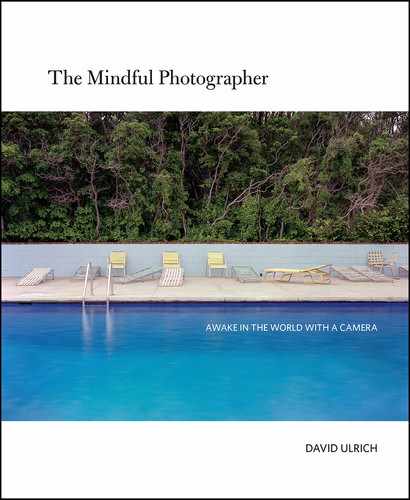Mapping the Internal Terrain
What is the shape of your inner landscape? Where lie your peaks and valleys, strengths and weaknesses, flowing streams of energy and blocked passages? Who am I? The eternal question is renewed in each individual and calls for not a fixed answer but a vigorous approach to uncovering the truths of your existence.
There cannot be a definitive answer; it shifts and changes throughout one’s life. Your personality adjusts to changing conditions and your true nature hopefully grows and evolves from birth.

Ice & Light #2, Kent, Ohio, David Ulrich
There is an art to turning inward, and, in my experience, many art and photography students today don’t feel the need for sustained, deep inner exploration. I don’t want to generalize because some students emphatically embrace the discovery of their inner worlds. Often though, the inner search has been replaced with examinations of identity, the relativity of experience due to such factors as race, ethnicity, gender, socioeconomic status, sexual preference, and political views. Certainly, these factors are worthy of, and demand exploration. But all of these can be seen as the outer edge of our deepest nature. They do not constitute the whole of a human being and our complex dynamics.
Maybe it’s an age-old theme. Some are hungry for inner wisdom and some locate meaning in the circumstances of external existence; and these are not mutually exclusive interests. I have been gifted through education and perhaps through my intrinsic nature with an understanding of symbol and metaphor—and know that photographs reflect the inner world of their maker in very precise and comprehensive ways.
Many of the ideas in this book can help one forge a dialogue with the world and culture through a camera. Here, I am espousing the foundational need to know oneself—as fully possible and in an ongoing manner. The search for one’s true nature forms the heart of many of the world’s wisdom traditions. In the best of worlds, art and photography can be allied with the means and tools of these traditions to offer deep insight into the nature of self and one’s personal angels, demons, obstacles, and gifts. Many photographs can be explored and read as direct reflections of your inner world in light of both their literal and metaphoric content.
With the aim of self-knowledge, get to know your own personal metaphors and symbols, and observe how they recur in your work and, over time, grow and change. The things you most resonate with in the world represent pieces of yourself. After observing these recurring symbols, metaphors, and visual gestalts in your work, begin the process of interpretation and untangling their complicated meaning.
Whether you intend it or not, the photographs you take say as much or more about you than they do the subject. Study them with a critical eye. Let no detail be considered unimportant especially if you find yourself attracted to similar things again and again. Our attractions reflect our being. Images can show the outline of a current map of your internal terrain and they can also be prescient. I have seen, time and again, symbols appearing in my work that were confusing as to their source, only to discover, over time, that they were harbingers of a future condition in my life. In my photographic projects, I have noticed that certain images, often made toward the end of an exploration, seemed new and different and clearly did not fit within my current project. They raised new questions and generated new insights. I have come to deeply respect the revelations from the depths of the mind that often exceed my rational understanding.
In one instance, I was intuitively led to a place where I made a photograph of forms in ice that transfixed my attention in a kind of aesthetic arrest. I observed that these twisting, metaphoric shapes and forms were precise, exact transcriptions of my inner world. I could observe where in myself energy moved freely and where there were blockages and limitations.
Sometimes the metaphors found in nature or urbanity that are reflected in your photographs can be read freely as messages or manifestations from within. Learn to read your symbols and metaphors with a free imagination and without reservation. Simple word associations can help understand your own symbolic language. For example, when you see the shape of an outstretched tree appearing frequently in images, ask yourself what the very first word or concept is that comes to mind in response to its shape or form. Be free and do not edit or judge your associations. Just observe what comes to mind and see if you can relate your associations with the metaphor found in the photograph.
Looking at your own images in silence with a still mind can help. What rhythms and movements are felt in your body? What emotions arise? What do the metaphors and symbols evoke in your mind?
The characteristics and shape of your inner world—its harmonies, gifts, strengths, conflicts, complexes, and obstacles—are made visible if you can learn to read their mysterious language. The brain thinks in words and concepts, the unconscious speaks in metaphor, symbol, and allegory, often wordlessly with form. Thinking in form and color is part of the deeper language of the mind that we can learn to read. Look at works of art, beyond just photography. Study symbols themselves but remember that your symbolic language is personal and cannot be fully explicated through universal descriptions. Learn to use symbols and metaphors consciously, intentionally, and not only as features that bubble up spontaneously from the subconscious.
Treat this exploration as a question that doesn’t have a fixed or definitive answer, but as a process in which the material unfolds organically through your study and your lived experience.
